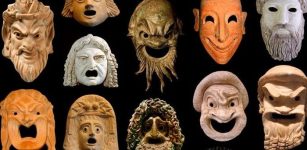Hydra Greek Monster: Fearsome Multi-Headed Dragon That Inhabited Swamps Of Lerna
A. Sutherland - AncientPages.com - In Greek mythology, strange, mythological creatures played a leading role in the stories of heroes and gods. These creatures have both an unusual or terrifying appearance and supernatural powers.
 The Lernaean Hydra. Attic amphorae from the 5th century BC. source
The Lernaean Hydra. Attic amphorae from the 5th century BC. source
One of them was the Hydra of Lerna, also known as the Lernaean Hydra, a multi-headed reptilian child of Echidna, the nymph, and the monster Typhoon. It symbolizes the difficulties in the fight against evil: a new one immediately grows when one of her heads is cut off.
In Greek and Roman mythology, the Hydra ("water snake") dwelled in the marshes near the Lake of Lerna, a bottomless lake connected to the Underworld, sometimes known as Hades. Hydra was a guardian of one of the entrances to Tartarus and the sibling of Cerberus, the goat/lion/serpent Chimaera, the two-headed hound Orthos, the Sphinx, the Nemean Lion, and the Krommyonian Sow.
She was a terrifying monster who poisoned enemies with her breath and blood. She possessed many heads, but their exact number varies, depending on the version of the myth.
Seven Or Nine Heads And The Ability To Regenerate
Hydra is often described and depicted as having seven or nine heads, the middle of which was immortal. In later versions of the Hydra myth, the monster possessed the ability to regenerate, and for every head chopped off, it could quickly regrow two heads.
Occasionally, depictions show her with dragon claws and a torso covered with hard scales, wings, or feet, while the body resembles a gigantic dog.
Hydra's breath was so poisonous it could kill any man who breathed it, and blood was toxic and capable of killing a man instantly.
Slaying The Multi-Headed Hydra
Hydra was defeated by Hercules (Heracles), a divine hero in Greek mythology, the son of Zeus and Alcmene, in the second of his twelve labors.
Hercules and the Hydra. John Singer Sargent, Museum of Fine Arts, Boston
Upon reaching the lake where the monster lived, Heracles fired his arrows so Hydra would come out of its depths and fight with him. Heracles cut off one of his heads with his sword, but a new head emerged from his body.
Scorpions and snakes appeared from the blood that the monster shed on the ground. To continue with his dangerous task, Heracles asked the assistance of his nephew Iolaus to cut off all of the monster's heads, along with the creature's immortal head of gold) and burn the neck using a sword and fire.
Finally, the fearsome and hideous creature that terrorized both people kidnapped cattle, and devastated fields, was defeated once and for all.
Heracles buried the immortal head of the Hydra under a large boulder; thus, his second labor was completed.
Legend Of Water Monster – The African Hydra
According to another myth, the water snake, known as the African Hydra, had seven heads and the ability to control the water level in the river, which was her home.
The people made offerings to the creature to ensure the river's flow. One legend says that a couple decided to offer their daughter, Jinde, as a wife to the Hydra in return for a constant water supply. The girl begged the creature to let her return home to visit her parents; the Hydra agreed but swore if she did not return after one day, it would come after her.
For fear of the monster, Jinde's parents refused to help her escape from the Hydra, so the girl sought the assistance of her boyfriend. When Jinde did not return, the Hydra left her realm to retrieve his bride. Instead of the girl, the Hydra met Jinde's lover, who fought the monster and was able to decapitate each of its seven heads.
Hydra Symbolizes Difficulties And Obstacles
Many believe that the Hydra of Lerna is more than only one of the many fascinating monsters in the colorful Greek myths and legends.
The creature symbolizes difficulties and obstacles that multiply while accomplishing a task. Some others believe that the story of the Hydra of Lerna refers to the problems the region's inhabitants suffered when they drained a marsh to reclaim their land for their own protection.
Sometimes various problems appear over and over again, constantly tormenting our lives.
Updated on March 1, 2023
Written by - A. Sutherland - AncientPages.com Senior Staff Writer
Copyright © AncientPages.com All rights reserved. This material may not be published, broadcast, rewritten or redistributed in whole or part without the express written permission of AncientPages.com
Expand for referencesReferences:
Routledge, Handbook of Greek Mythology
Clevenger S. Greek Mythic History
Goldstein J. 101 Amazing Mythical Beasts
Bane T. Encyclopedia of Beasts and Monsters in Myth, Legend, and Folklore
More From Ancient Pages
-
 Etruscan Beautiful Bronze Lamp of Cortona – Studied
Artifacts | Apr 10, 2024
Etruscan Beautiful Bronze Lamp of Cortona – Studied
Artifacts | Apr 10, 2024 -
 How Important Was Dance In Ancient Egypt And What Purpose Did It Serve?
Ancient History Facts | May 5, 2021
How Important Was Dance In Ancient Egypt And What Purpose Did It Serve?
Ancient History Facts | May 5, 2021 -
 On This Day In History: Pakal Ascends The Throne Of Palenque At Age Of 12 – On July 29, 615
News | Jul 29, 2016
On This Day In History: Pakal Ascends The Throne Of Palenque At Age Of 12 – On July 29, 615
News | Jul 29, 2016 -
 Evidence Of Legendary Ancient Great Flood In China May Re-Write History
Chinese Mythology | Aug 5, 2016
Evidence Of Legendary Ancient Great Flood In China May Re-Write History
Chinese Mythology | Aug 5, 2016 -
 How The Handbook ‘Hammer Of Witches’ And Then-Existing Networks Inspired Europe’s Witch Craze
Social Sciences | Oct 10, 2024
How The Handbook ‘Hammer Of Witches’ And Then-Existing Networks Inspired Europe’s Witch Craze
Social Sciences | Oct 10, 2024 -
 Warming Of North Pacific Helped First Human Migration From Asia To North America
Archaeology | Dec 15, 2020
Warming Of North Pacific Helped First Human Migration From Asia To North America
Archaeology | Dec 15, 2020 -
 5,000 Years Old Beer Enjoyed By Egyptian Pharaohs Recreated
Archaeology | May 23, 2019
5,000 Years Old Beer Enjoyed By Egyptian Pharaohs Recreated
Archaeology | May 23, 2019 -
 Enigma Of Ancient Bell-Shaped Metal Vase Found In Solid Sedimentary Rock
Artifacts | Jun 6, 2019
Enigma Of Ancient Bell-Shaped Metal Vase Found In Solid Sedimentary Rock
Artifacts | Jun 6, 2019 -
 Reconstructing The Lost Ancient World Of The Marquesas Islands With Unique Plants And Animals
News | Mar 31, 2022
Reconstructing The Lost Ancient World Of The Marquesas Islands With Unique Plants And Animals
News | Mar 31, 2022 -
 Mysterious Fossilized Antarctic Forest May Offer Evidence Of The Great Flood – But Some Facts Speak Against This Theory
Archaeology | Dec 27, 2017
Mysterious Fossilized Antarctic Forest May Offer Evidence Of The Great Flood – But Some Facts Speak Against This Theory
Archaeology | Dec 27, 2017 -
 Svarog: God Of Cosmic Fire And Ruler Of The Sky In Pre-Christian Slavic Pantheon
Featured Stories | Aug 15, 2017
Svarog: God Of Cosmic Fire And Ruler Of The Sky In Pre-Christian Slavic Pantheon
Featured Stories | Aug 15, 2017 -
 Ancient Native Americans’ Encounter With The Star People – An Otherworldly Rescue?
Ancient Mysteries | Jul 20, 2021
Ancient Native Americans’ Encounter With The Star People – An Otherworldly Rescue?
Ancient Mysteries | Jul 20, 2021 -
 18th Century Potter Atmospheric Steam Engine Found In Slovakia
Archaeology | Jul 24, 2020
18th Century Potter Atmospheric Steam Engine Found In Slovakia
Archaeology | Jul 24, 2020 -
 Ancient Greeks Regret Inventing The Theater – But Why?
Ancient History Facts | Jul 26, 2018
Ancient Greeks Regret Inventing The Theater – But Why?
Ancient History Facts | Jul 26, 2018 -
 Seti I – Remarkable Pharaoh Who Saved The Kingdom Of Egypt And Gave It New Glory
History | Jun 15, 2021
Seti I – Remarkable Pharaoh Who Saved The Kingdom Of Egypt And Gave It New Glory
History | Jun 15, 2021 -
 Small Stone Carved With A Viking Ship May Be Oldest Picture Ever Found In Iceland
Archaeology | Jun 16, 2023
Small Stone Carved With A Viking Ship May Be Oldest Picture Ever Found In Iceland
Archaeology | Jun 16, 2023 -
 Legend Of The Immortal Wandering Jew Cursed By Jesus
Biblical Mysteries | Jul 17, 2018
Legend Of The Immortal Wandering Jew Cursed By Jesus
Biblical Mysteries | Jul 17, 2018 -
 Unexplained Case Of Ancient Authors Who Foretold One Of the World’s Greatest Catastrophes
Ancient Mysteries | Oct 13, 2018
Unexplained Case Of Ancient Authors Who Foretold One Of the World’s Greatest Catastrophes
Ancient Mysteries | Oct 13, 2018 -
 First Detailed Academic Study Of East African Maritime Traditions Shows Changes In Boatbuilding
Archaeology | May 11, 2022
First Detailed Academic Study Of East African Maritime Traditions Shows Changes In Boatbuilding
Archaeology | May 11, 2022 -
 Gallic Leader Vercingetorix In Victorious Battle Of Gergovia, 52 BC
Featured Stories | Jan 23, 2017
Gallic Leader Vercingetorix In Victorious Battle Of Gergovia, 52 BC
Featured Stories | Jan 23, 2017

